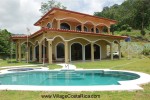As readers may remember, one of the provisions of the Central American Free-Trade Agreement with the United States (CAFTA) was that the National Insurance Institute’s monopoly in the insurance market (since 1924) had to be broken.
In July 2008, laws were changed to allow this, and in August 2008 the Insurance Superintendency (SUGESE) was formed to oversee the entire industry. Shortly thereafter, SUGESE enacted a series of regulations establishing the conditions whereby new actors in the market can become licensed, as well as the conditions for the operation of the entire insurance industry.
To obtain a license to operate, insurance companies (also brokerages and agencies) must go through a complex process, greatly summarized as follows:
1. An application must be presented to SUGESE, outlining the corporate details and a business plan for the first three years. I have heard of application dossiers of nearly 1,000 pages.
2. If SUGESE finds the dossier clear and complete, it accepts it for study. If not complete, if additional information is required or if some of the conditions are not acceptable to SUGESE, a two-month delay ensues while the information is completed, supplemented or corrected by the applicant.
3. When the application is to the satisfaction of SUGESE, it issues an autorización condicionada (conditional authorization) whereby the applicant is given two months to get his act together and fulfill the promises made to SUGESE: form a corporation, set up the books, arrange for office space and equipment, hire personnel, install computer programs, establish a costly guarantee, etc., etc.
4. When all is in place, SUGESE sends an inspector to so verify. Anything missing or not to the satisfaction of SUGESE means a delay of up to two months. When all is well, SUGESE will issue a licencia de funcionamiento (operating license).
Once the operating license is in hand, one would think that insurance companies could open for business. Not so. There are still some steps missing:
1. All insurance products (types of policies) have to be vetted by SUGESE, which will study the contract conditions, monetary viability, reserves to be established, pricing, etc.
2. The sales force must be licensed. If an insurance company is going to sell through in-house agents, each must be individually licensed by SUGESE, which will require an entire dossier outlining and proving relevant studies and/or work experience. If sales are going to be focused through brokerages, these must be licensed by SUGESE, as must each broker working within a brokerage.
As my readers can imagine, this all takes time. What is the current situation?
Insurance Companies
–The National Insurance Institute, or INS, the “ex-monopoly,” is smartening up. Products have been improved, and premiums have been reduced in the lines where there is incipient competition. They have a full line of approved products, which they sell through several hundred agents and about 80 agencies (TT, Aug. 20).
–Mapfre, a world-class Spanish insurer, was licensed to sell auto insurance as of June. Sales are through about 50 in-house agents, but Mapfre will also operate through brokerages.
–Alico Costa Rica, a subsidiary of a company owned by American International Group and in the process of being acquired by MetLife, has had some group life and medical products approved, which it will offer through brokerages. The company expects to have individual products ready by January 2011.
–Pan-American Life Insurance Company, from the United States, expects to have approval at the end of August to sell group life and medical products. Individual policies will be available in early 2011. Sales will be through brokerages.
–ASSA, the foremost Panamanian company, has received approval for 13 products in dollars and 13 products in colones. These include casualty products such as liability, auto, fire, etc., but not personal insurance. Sales are through brokers.
–Seguros Bolívar, from Colombia, received its conditional authorization on May 13.
–Aseguradora del Istmo of Panama received its conditional authorization on May 12.
–Quálitas of Mexico received its conditional authorization on Aug. 13.
Brokerages
–Banco de Costa Rica and Banco Nacional have established brokerages whose function is to protect and insure the banks’ portfolios.
–Avanto, the first “private” brokerage, came on stream July 7. It has two licensed brokers.
–Confía received its conditional authorization June 29.
–Unity received its conditional authorization July 27.
–Unicen, of which the writer is a partner, expects to come on stream late August with three brokers.
The opinions and viewpoints expressed are those of the writer. Our purpose is to give the reader a better understanding of insurance in Costa Rica. For more information, contact David Garrett at 2233-9520 or[email protected].








